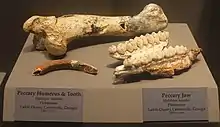Mylohyus
Mylohyus is an extinct genus of peccary found in North and Central America. It first evolved during the Late Miocene and became extinct at the end of the Pleistocene, around 12,000 years ago.
| Mylohyus | |
|---|---|
 | |
| M. nasutus | |
| Scientific classification | |
| Domain: | Eukaryota |
| Kingdom: | Animalia |
| Phylum: | Chordata |
| Class: | Mammalia |
| Order: | Artiodactyla |
| Family: | Tayassuidae |
| Genus: | †Mylohyus Cope, 1869 |
| Species | |
| |

Six species were known, the most famous being Mylohyus nasutus, also known as the long-nosed peccary. The genus was slightly larger-bodied than any modern peccaries, with an estimated mass of 68 kg (150 lb).[1]
Isotope and anatomical studies have suggested that the diet of Mylohyus varied over geological time, from being primarily a C3 browser during the Blancan, with an increasing consumption of C4 vegetation during the Irvingtonian, with a relatively even mixture of C3 and C4 during the Rancholabrean. Suggestions have been made that it was frugivorous and also consumed hard browse like twigs.[2]
Sources
- The Paleobiology Database: Mylohyus
- Bradham, Jennifer L.; DeSantis, Larisa R.G.; Jorge, Maria Luisa S.P.; Keuroghlian, Alexine (June 2018). "Dietary variability of extinct tayassuids and modern white-lipped peccaries ( Tayassu pecari ) as inferred from dental microwear and stable isotope analysis". Palaeogeography, Palaeoclimatology, Palaeoecology. 499: 93–101. doi:10.1016/j.palaeo.2018.03.020. S2CID 134099913.